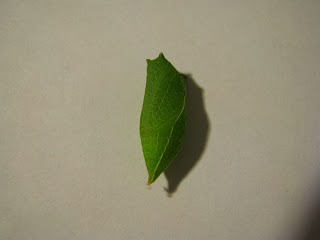The larvae of this species feed only on plants from the family Annonaceae, and in North America, the predominant food plant is Asimina triloba (common pawpaw). There are other species of Asimina found in North America, and some of these can also serve as host plants occasionally. For example, in Florida, the larvae of the Zebra Swallowtail will happily feed on Asimina angustifolia (slimleaf pawpaw), Asimina reticulata (netted pawpaw), or Asimina pygmea (dwarf pawpaw). This genus is closely related to the genus Annona, which contains species that produce some commercially important fruit such as the cherimoya and custard apple. However, I am uncertain if the butterfly can also feed on plants from the Annona genus.
Both the food plant and butterfly species are rare where I live, but a few years ago, I lived in Washington DC for a period of time, and was able to locate this species and raised 3 caterpillars on common pawpaw. I also saw this species when I visited Florida recently, but did not raise any from that trip as I didn't have the food plant available to me at that time of year.
The picture above is of a 5th instar caterpillar on common pawpaw. It pupated a couple of days later as I recall.
This butterfly emerged the following day, and was a male (top picture). The bottom picture is of the same butterfly, now set as a specimen.
As fortune would have it, I recently located some common pawpaw fruit, and will try to grow some plants from seed. Once they are large enough, I may try my hand at raising this species again and take additional photographs.
The common pawpaw is actually the largest native fruit in North America, but is not well known and is not usually available in grocery stores. They do not ship well, and spoil in a short period of time. There are some places that sell them, and some research is currently being done to try to commercialize the fruit and improve its shelf life. A lot of this work is being done at Kentucky State University, and if I recall correctly, Ohio also has an annual pawpaw festival. The fruit are tropical looking and mature in September/October. When mature, the skin turns from green to yellow, similar to a banana. In fact, pawpaw is sometimes also known as the prairie banana, though it neither grows in prairies nor is it related to bananas. Inside, the pulp is soft and yellow. It's hard to describe the flavor to someone who has not eaten pawpaw, but some say it's a combination of mango and banana. I think it's closer to mango, but the pulp is really soft and not stringy at all.
Inside each pawpaw fruit are usually two rows of brown flat seeds, each about the width of a quarter. I have a bunch of these now, and will try to germinate them next spring. In order for them to germinate optimally, they require several months of cold moist stratification, which basically means you have to keep them cold and moist for a while (can be done in a fridge). The cold treatment breaks the dormancy of the seeds.
The mature tree is pyramidal shaped with large drooping leaves, as shown above.








No comments:
Post a Comment